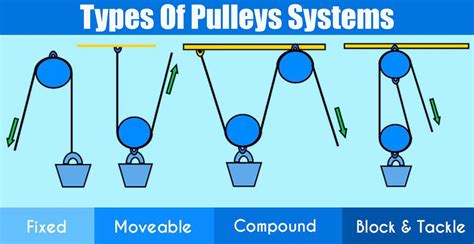The Ultimate Guide to Pulleys: Harnessing Mechanical Advantage with Simple Machines
Introduction
Pulleys are essential mechanical devices that have revolutionized the way we move objects and perform work. From lifting heavy weights to hoisting sails, pulleys play a crucial role in countless applications across various industries. This comprehensive guide will delve into the basics of pulleys, their different types, advantages, and applications, providing actionable tips for effective use.
What are Pulleys?
A pulley is a simple machine consisting of a grooved wheel and a rope or cable that runs around the groove. When force is applied to one end of the rope, the force is transmitted through the pulley to the other end, resulting in the movement of an object. Pulleys allow us to change the direction and magnitude of force, making it easier to lift or move objects.
Types of Pulleys
There are three main types of pulleys:

-
Fixed Pulley: Attached to a stationary support, a fixed pulley changes the direction of force but does not provide any mechanical advantage.
-
Movable Pulley: Attaches to the object being moved and provides a mechanical advantage, making it easier to lift the object.
-
Compound Pulley: Combines multiple pulleys to create a system that provides even greater mechanical advantage.
Mechanical Advantage of Pulleys
The mechanical advantage of a pulley system is the ratio of the output force (the force applied to the object) to the input force (the force applied to the rope). For a single fixed pulley, the mechanical advantage is 1. For a single movable pulley, the mechanical advantage is 2. Compound pulley systems can provide even greater mechanical advantages.
Applications of Pulleys
Pulleys find applications in a wide range of industries, including:
-
Construction: Lifting heavy materials, hoisting equipment
-
Marine: Hoisting sails, hauling equipment on boats
-
Automotive: Adjusting tension in belts and cables
-
Industrial: Moving heavy machinery, lifting loads in factories
-
Fitness: Exercise machines, weightlifting equipment
Common Mistakes to Avoid
When using pulleys, it is important to avoid common mistakes that can reduce their effectiveness or cause accidents:
-
Overloading: Do not exceed the weight capacity of the pulley or the rope.
-
Ignoring Friction: Account for friction in the system, which can reduce the mechanical advantage.
-
Improper Rope Handling: Ensure that the rope is wound evenly around the pulley to prevent slippage and damage.
-
Insufficient Lubrication: Lubricate pulleys regularly to reduce friction and extend their lifespan.
How to Use Pulleys
Step 1: Determine the Required Mechanical Advantage
Calculate the ratio of the weight of the object to the force you can apply. This will determine the type and number of pulleys required.
Step 2: Choose the Appropriate Pulleys

Select fixed, movable, or compound pulleys based on the required mechanical advantage and the application.
Step 3: Set Up the Pulley System
Attach the pulleys to a support structure and connect the rope or cable as per the desired configuration.
Step 4: Apply Force
Apply force to the free end of the rope to lift or move the object.
Pros and Cons of Pulleys
Pros:
-
Mechanical Advantage: Increase the force available for lifting or moving objects.
-
Change in Direction: Allow for force to be applied in different directions.
-
Compact Size: Relatively small and easy to store or transport.
-
Versatility: Applicable in various industries and for various purposes.
Cons:

-
Friction: Friction in the system can reduce mechanical advantage and increase wear on components.
-
Weight: Compound pulley systems can be heavy, limiting portability.
-
Maintenance: Regular lubrication and maintenance are necessary to ensure proper function.
FAQs
- What is the efficiency of a pulley system?
The efficiency of a pulley system is typically around 80-95%, due to friction and other losses.
- Can pulleys be used to lift heavier objects than their rated capacity?
No, exceeding the rated capacity of a pulley can damage the equipment and pose safety risks.
- What types of ropes can be used with pulleys?
Typically, nylon, polyester, or steel cables are used with pulleys, depending on the application and weight requirements.
- How often should pulleys be inspected?
Regular inspections are recommended every 6 months or as per manufacturer's guidelines.
- How do I choose the right pulley system for my application?
Consider the weight capacity, required mechanical advantage, and intended use to determine the appropriate pulley configuration.
- What safety precautions should I take when using pulleys?
Inspect equipment before use, use appropriate lifting techniques, and avoid overloading or exceeding the rated capacity.
Conclusion
Pulleys are indispensable tools that provide mechanical advantage and facilitate the movement of heavy objects or the change in force direction. Understanding the principles of pulleys, their types, and applications will empower you to harness their power effectively. By avoiding common mistakes and following best practices, you can ensure the safe and efficient operation of pulleys, maximizing their performance and longevity.
